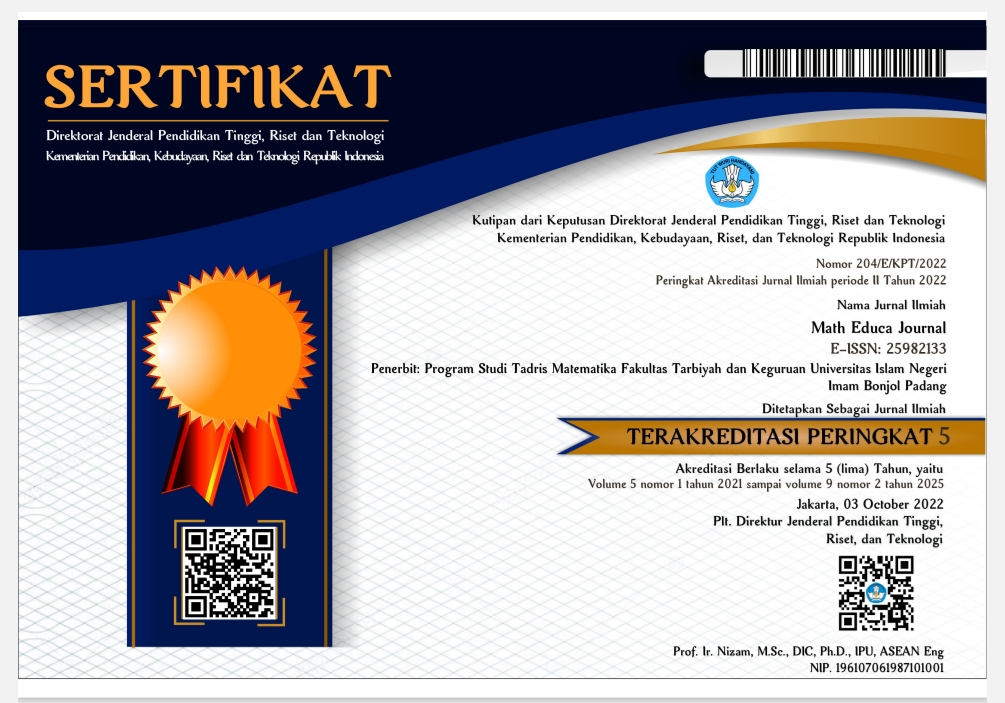Ethnomathematics Pada Ornamen Rumah Gadang Minangkabau
Abstract
The mathematical concept on cultural objects is one of the objects of study in the study of ethnomathematics. This study aims to uncover mathematical concepts in the ornaments found in the rumah gadang and the development of ornaments. This qualitative research uses participatory observation techniques and documentation to obtain data. The results showed that there were geometrical concepts in the ornaments and the development of the rumah gadang ornaments. The concepts of geometry seen in ornaments include the use of two-dimensional such as square, rectangular, rhombic, circle, ellipse and polygons. Two-dimensional shape are also arranged using certain patterns. The development of ornament forms is carried out using the principles of congruence, tessellation, symmetry patterns and geometric transformations (translation, reflection, rotation, and dilation). The results of this study can be used as a reference for teachers in mathematics learning and ethnomathematics research on cultural objects.
Keywords: ethnomathematics, ornaments of rumah gadang
Full Text:
PDFReferences
A.M.Y Dt. Garang, H. A. (1983). Pengetahuan Ragam Hias Minangkabau. Jakarta: Dirjen Pendidikan Dasar dan Menengah Depatemen Pendidikan dan Kebudayaan.
Barton, W. . (1996). Ethnomathematics :Exploring Cultural Diversity in
Mathematics. University of Auckland.
Bishop, A. J. (1997). Mathematical Enculturation: A Cultural Perspective on mathematics Education (Third). The Netherlands: Kluwer Academic Publishers.https://doi.org/10.1007/978-94-009-2657-8
Creswell, J, W. (2009). Research Design:Qualitative, Quantitative, and Mixed Methods Approaches. 3rd Edition. Los Angeles: SAGE Publications, Inc.
D'Ambrosio, U. (2001). What is ethnomathematics, and how can it help
children in schools? Teaching Children Mathematics , 308.
Fauziah & Niniwati. (2017). Ethno-mathematics Exploration on the Carvings of Rumah Gadang in South Solok Regency of West Sumatera. IJRDO-Journal of Educational Research , 134-148.
Fitriza, R., (2018). Studi Ethnomathematics Pada Arsitektur Tradisional Rumah Gadang Sumatera Barat dan Penerapannya Dalam Pembelajaran Matematika Di Sekolah. Bandung: Disertasi, Universitas Pendidikan Indonesia.
Haryanto, T. S, Nusantara, Subanji & Abadyo. (2016). Ethnomathematics in Arfak (West Papua-Indonesia): Hidden Mathematics on knot of Rumah Kaki Seribu. Academic Journals , 420-425.
Hasni, S. (1999). Ukiran Tradisional Minangkabau. Padang: Depdikbud, Direktorat Jenderal Kebudayaan.
Helsa, Y., & Hartono, Y. (2011). Designing Reflection and Symmetry Learning by Using Math Traditional Dance in Primary School. IndoMs – JME, 2(1), 79 – 94.
Jurgensen, R. B, Brown, R.G & King, A. M.(1983). Geometry. Boston: Houghton Mifflin Company.
Khaira, K. (2017). Study of Ethnomathematics: Investigasi Ide Matematis Pada Ukiran Rumah Adat Tradisional Minangkabau. Bandung: Skipsi: UPI.
Massarwe, K.I. (2010). An Ethnomathematics Exercises in Analyzing and Constructing Ornaments in a Geometry Class. Journal of Mathematics and Culture, 5(1).
Navis, A. (2015). Alama Takambang Jadi Guru: Adat dan Kebudayaan Minangkabau.Padang: PT Grafika Jaya Sunmbar.
Rosa, M. & Orey, D.C. (2009). Symmetrical Freedom Quilts: The Ethnomathematics of Way of Communication, Liberation, and Art. Revista Latinoamericana de Etnomatematica, 2(2), 52-75
Soeroto, M. (2005). Pustaka Budaya dan Arsitektur: Minangkabau. Jakarta: Myrtle Publishing.
Syamsidar. (1991). Arsitektur Tradisional Daerah Sumatera Barat. Jakarta: Depdikbud, Direktorat Jendral Kebudayaan Direktorat sejarah dan Nilai Tradisional Proyek Inventarisasi dan Pembinaan Nilai-nilai Budaya.
Refbacks
- There are currently no refbacks.
The Journal Space of the Mathematics Education Department
Faculty of Education and Teacher Training
State Islamic University of Imam Bonjol Padang
Email: mej.uinibpadang@gmail.com

Math Educa Journal is licensed under a Lisensi Creative Commons Atribusi-NonKomersial 4.0 Internasional.
Based on a work at https://ejournal.uinib.ac.id/jurnal/index.php/matheduca.
All rights reserved p-ISSN: 2580-6726 | e-ISSN: 2598-2133




